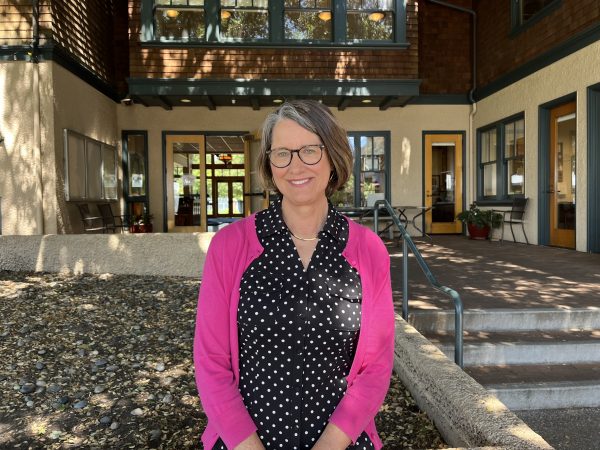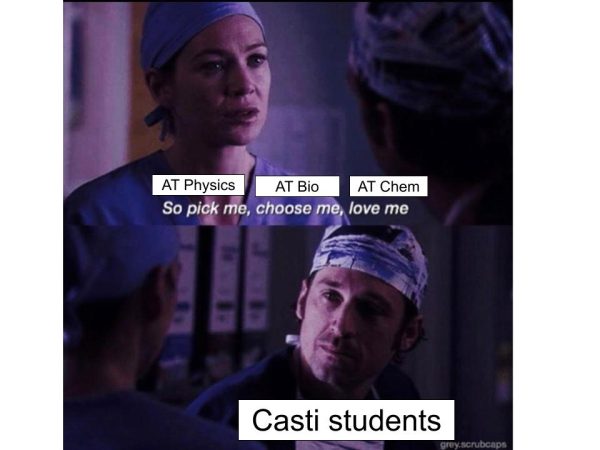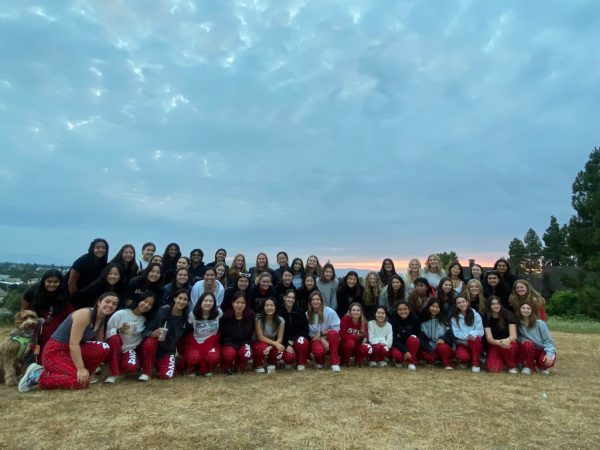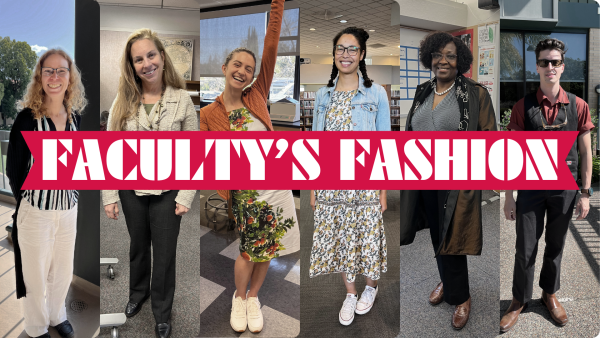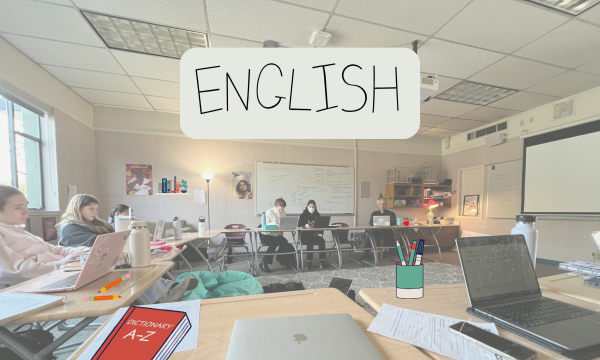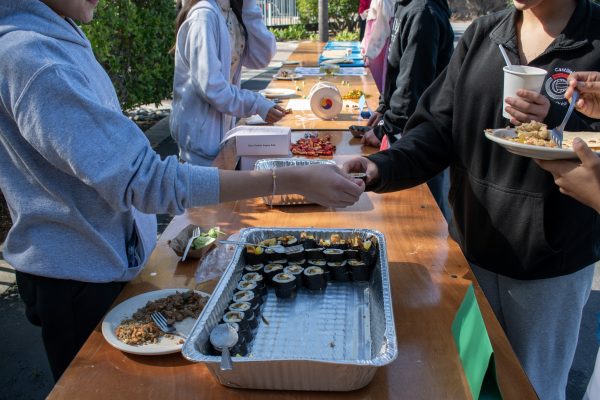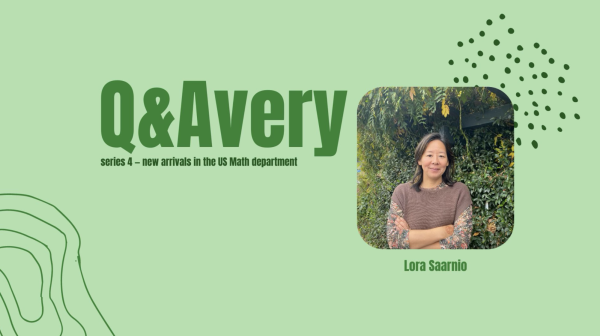The Sixth C: Cauffman
“Kauffman’s life is defined by her prevailing value of education—particularly women’s education.”
Early in the fall of my senior year, I thought of doing a Counterpoint piece about Nanci Kauffman, who, even though I have been at Castilleja for almost seven years, has always been an opaque figure to me. After getting the go-ahead from my editors in September, I reached out to Kauffman about an interview, honestly not expecting very much.
Much to my surprise, I got an immediate response. It was an “Out of Office” auto-response. Kauffman was vacationing in Italy.
But, as I have continually learned as an upperclassman at Castilleja, the adults on campus are—shockingly—interested in talking to the students. A few days later, Kauffman emailed back saying she would be “thrilled” to be interviewed.
***
Nanci Kauffman has been employed at Castilleja, in some capacity or other, for almost twenty-four years. Starting as a middle school History teacher in 1999, she became Head of School in 2010. Few employees have been at the school longer than she has, and my time at Castilleja has been indelibly marked by her leadership. Sitting in her office, I felt as though I was looking at some permanent fixture of Castilleja. As we talked, her work at Castilleja seemed to be almost the capstone to her life.
Kauffman told me that she feels as though a Head of School cannot be around longer than 15 or 20 years— “people can start to feel like no one else could do the job.” And so, as her tenure as Head of school approaches the bottom threshold of that cap, I found that it was appropriate to reflect on Kauffman and Castilleja in relation to one another.
Kauffman grew up in Valley Stream, a town on Long Island, where she attended public schools. Her high school was small, around 200 students, which contributed to a sense of closeness and community among her peers. “I used to say,” Kauffman said, “that it was totally different [from Castilleja].” But the similarities, as we kept talking, became obvious: “The thing that was unique about my public school is that it was grades seven through 12. Back then junior high was seventh and eighth grade, and I think the fact that we all were in the same school for all those years, which was not typical in a public school, [made us] closer.” She’s still in touch with her high-school friends, and six of them do trips together for their major birthdays.
Kauffman worked through high school, mainly babysitting. It is unclear how attentive a babysitter Kauffman was. Once, the family she was babysitting had to make an emergency interruption on the house’s phone line to check in because Kauffman had been talking to her boyfriend for hours. “You guys have no idea how life was without a cell phone,” she said.
She kept her sights set on college, and she worked hard for the grades to get there, ending up studying psychology at Vassar. In Valley Spring, over eighty-percent of high school graduates went on to four-year colleges. But, unlike in the Silicon Valley private school environment, “there was [not a lot of] pressure around where you were going to go to college and what you were going to do with your career”— “like just, much, much less.” Of the six friends Kauffman travels with, three continued their education and three pursued different paths.
The interviews for this profile were right in the throes of intense college application season for seniors. While countless people assured me that I should just focus on finding the “right school for me,” I never was able to shake the perceived pressure to attend a “big name” university. I told Kauffman about how many people’s parents see Castilleja as a major gateway to highly-ranked colleges—which, as the eighteenth best private school in the country, according to Niche, it is.
Kauffman has kids of her own—one son and one daughter: “I like to say neither one of my kids peaked in high school. Like, that is not the goal. They both went to good colleges that were perfect for them. They both came out the other end really well educated, independent and creative.”
In 1999, when Kauffman started at Castilleja, the term “college preparatory” was in the school’s mission statement. Now, you can’t even find the term on the school’s website. Kauffman tells me that now, “so much more of the focus is on the process of learning, creativity and collaboration.” But, there is a distinct tension between what Castilleja has been, what Castilleja wants to be, and what Castilleja is.
Castilleja was founded in 1907 as a women’s college preparatory school upon the urging of Stanford’s then-president, David Starr Jordan. Since the school’s founding, many Castilleja graduates have continued their educations at Stanford University (now, a handful go every year). Castilleja is tied to Stanford and what it represents, even as that has changed over time (Stanford was not considered a prestigious institution of higher education until around the 1960s).
When Kauffman became Head of School, she said in a parent meeting that “if your goal is for your daughter to go to Stanford, why not just send her to Paly? More kids from Paly go to Stanford than from Castilleja. But if your goal is for her to kick butt, no matter where she goes to college, you send her to Castilleja, because [of] the skills and the practice and everything that she gets from this school.” She said this with conviction.
Sometimes, during our interviews, I felt like I was being fed a marketing campaign. But, this feeling might be due to my own cynicism.
“What is sort of interesting about Castilleja,” Kauffman shared, “is that the parents whose daughters have graduated or are near graduating actually recognize the importance of the school more than almost anybody. [They’re grateful] for what [their daughter’s] high school experience has been and how she’s turned out. It’s all very recent for them and they want to see other girls have that. And so that’s where their generosity actually, I think, comes from.”
Around a quarter of Kauffman’s working time is spent fundraising. While it is admittedly not her favorite part of the job, she appreciates being able to connect with people who care about Castilleja. Castilleja’s tuition is high, but like all other institutions, its major projects are made possible by donations. For example, the school has raised over 80 million dollars (about half of its goal) for its impending renovation, largely thanks to parents and a handful of wealthy and generous alumni.
After graduating from Vassar in 1978, Kauffman made her way to Columbia’s Teachers College. As a teenager, she wanted to pursue a career in either teaching or primary care—career paths likely influenced by the roles she saw the professional women around her in: “I never thought about business. I never thought about engineering. There were a lot of things that just didn’t cross my radar.”
In New York, Kauffman taught at girls’ schools for a decade before moving out to California. In Vassar’s alumni magazine, Kauffman is quoted saying that “My first teaching job was at an all-girls school in Manhattan—the Marymount School of New York. I think I was there three days when I realized that having an all-girls education prepared women in ways that I hadn’t imagined.”
“I really care about what happens to the next generation of girls and women,” Kauffman said—it is why she has stayed at Castilleja for so long. She staunchly believes that the world “will be a better place if we do a good job educating girls to become really strong women.” And this is why being Head of School for Castilleja is Kauffman’s capstone: it is the best way she has found to ensure that there are strong people leading our future.
For someone who is the Head of School at an institution where some students have the worst work/life balance I have ever seen, Kauffman has a pretty good one. Her family is the most important part of her life—it’s the only thing that will keep her up at night. Both her kids live close to her, and they try to have family night dinners together (her son-in-law is an excellent chef). Her husband, Scott, seems to be her rock. They always try to have a Netflix show going—usually some foreign series (right now they’re watching Spiral and have “been learning a lot about the Paris police”).
I felt I needed to coax out one of Kauffman’s crazier stories. Her husband is one of the founders of the Entertainment Weekly Magazine, and so, she ended up at the 1992 Oscars:
It’s not really that wild, but it’s a funny story: It was the year that Thelma and Louise, the movie, won the Oscars. And Geena Davis was in the movie. I went into the restroom, and she was in the restroom—she had this dress; it looked like a bird. [She had] this big yellow dress, and I had to help her get into the restroom. It was just very odd, because she was a very big deal at that moment.
(There was another story from Vassar that features a Winnebago, six friends, and a “really pretty wild time,” but I do not think I will be the one to get that full story.)
Kauffman will likely be retiring soon, and even though she is apparently a West-Coaster for life now, she has a fantasy of retiring back to New York: “I just remember when I lived in New York, [seeing] these little old ladies who had their apartments on Fifth Avenue come down on the elevator and get in a taxi and go to the theater or something…”
The completion of the campus renovation will likely mark the near end of Kauffman’s time at Castilleja. But she’s not ready to retire quite yet: “I would love to be an interim head like once or twice just to see what that’s like. Go to a French American school or a school in, I don’t know, Australia or something and just have that chance to keep a school in a good place or solve some problems for them.”
Kauffman’s life is defined by her prevailing value of education—particularly women’s education. Her time at Castilleja, especially as its Head, has set the school on a new course: as class time has reduced and there has been an increased focus on developing a “whole person”—with the growth of the ACE center, the emphasis on anti-racist learnings, and the increase in speakers—the “Castilleja student” seems more intentionally “well-rounded.” The new campus project that Kauffman has spearheaded over the past decade seems to embody these changes, with intentionally designed interdisciplinary and collaborative spaces. Soon, Castilleja and Kauffman will begin to move past each other. But their pasts will always be intertwined.

Sara Baudler '23 is the Editor of News and the Editor of Humor for Counterpoint. Sara's life goals include being 6'3" and winning the Masters Tournament;...



